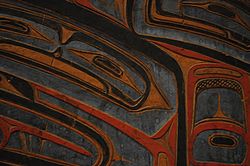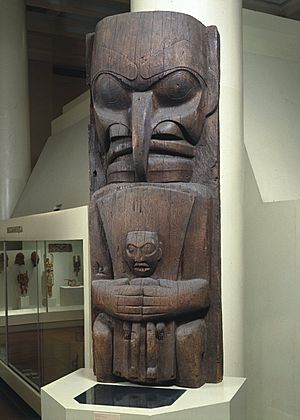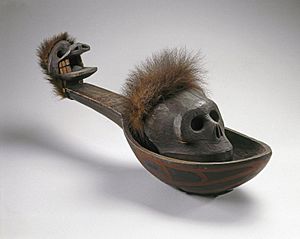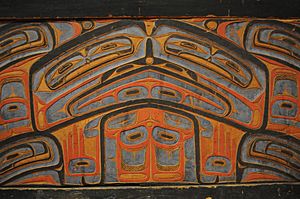Heiltsuk facts for kids

Detail of a 19th-century bentwood chest
by Heiltsuk artist Captain Richard Carpenter (Du'klwayella) |
|
| Total population | |
|---|---|
| 1,874 (1995) | |
| Regions with significant populations | |
| Canada (British Columbia) | |
| Languages | |
| English, Hailhzaqvla, Chinook jargon | |
| Religion | |
| traditional tribal religion |
The Heiltsuk or Haíɫzaqv are an Indigenous people who live along the Central Coast of British Columbia, Canada. Their main community is Bella Bella. The Heiltsuk people have their own government, called the Heiltsuk Nation.
Sometimes, people used to call the Heiltsuk "Bella Bella." But they are different from the Nuxalk people, who speak a Salish language. The Nuxalk were often called "Bella Coola," which came from a Heiltsuk word meaning "stranger."
Contents
Heiltsuk History and Ancestors
The ancestors of the Heiltsuk people have lived on the Central Coast of British Columbia for a very long time, at least since 7190 BCE. The Heiltsuk people today mainly come from groups who spoke the Haíɫzaqvḷa (Heiltsuk) language. They identify with five main tribal groups:
- W̓úyalitx̌v (Wuyalitxv) – the Seaward Tribe
- Q̓vúqvay̓áitx̌v (Qvuqvayaitxv) – the Calm Water Tribe
- W̓u̓íƛ̓itx̌v (Wuithitxv) – the Roscoe Inlet Tribe
- Y̓ísdáitx̌v (Yisdaitxv) – the Y̓ísdá Tribe
- X̌íx̌ís (Xixis / Xai’xais) – the Northern/Downriver Tribe
These groups came together in Bella Bella (called ’Qélc, meaning "Slippery") in the 1800s.
The Heiltsuk people had a rich culture, similar to other Northwest Coast Indigenous groups. They lived in large family groups and had special stories about where they came from. They moved with the seasons to gather food, living in big permanent villages during the winter. They were very skilled at using wood, stone, and other materials to create amazing things. They also had complex ceremonies and social events, including the 'potlatch'.
Recently, ancient "clam gardens" have been rediscovered along the coast of British Columbia. These were built by Indigenous people, including the Heiltsuk, to grow clams. The Heiltsuk were also well-known for their artistic, military, ceremonial, and spiritual skills.
First Contact with Europeans
The Heiltsuk likely first met Europeans in 1793. The name "Bella Bella" was first used in 1834. During the fur trade era, many Heiltsuk people sadly died from new diseases brought by Europeans. There were also more conflicts with neighboring groups.
The Heiltsuk became known as excellent traders. They were very skilled at making canoes and later learned to build Western-style ships. For a while, they acted as middlemen in the fur trade, which meant they bought furs from other groups and sold them to European traders. They were smart traders, sometimes asking for extra large blankets and then cutting them to make more blankets to trade!

A significant feature of Bella Bella society was the development of a cadre of highly skilled artisans noted for their construction and decoration of bentwood boxes, chests, canoes, and horn spoons and ladles. After White contact the skills of these artisans were turned to the market demand for canoes and boxes.
—Susan F. Hilton, Haihais, Bella Bella, and Oowekeeno
The Heiltsuk faced terrible population loss due to diseases and conflicts. For example, a war between the Heiltsuk and the Haida ended in 1852 with a peace agreement.
Moving to New Bella Bella
Between 1832 and 1900, some Heiltsuk people built a village in McLoughlin Bay, next to the Hudson's Bay Company's Fort McLoughlin. This village was called Bella Bella or Qlts. Other Heiltsuk groups joined them there in the late 1800s.
For the period before 1897 the name Bella Bella refers only to 'Qelc, or to Old Bella Bella (Old Town), at McLoughlin Bay.
—Martha Black, Bella Bella: A Season of Heiltsuk Art
The Heiltsuk community at Old Bella Bella (McLoughlin Bay) had to move to the current village of Bella Bella (also called Waglisla). This move happened partly because of attempts by colonists to harm the community with diseases like smallpox.
By 1903, the Heiltsuk had built and mostly moved into the current village of Bella Bella. Like other First Nations on the coast, the Heiltsuk suffered greatly from diseases like smallpox. The 1862 Pacific Northwest smallpox epidemic alone killed about 72% of the Heiltsuk people. This huge loss of life caused the Heiltsuk to come together into fewer communities. By 1919, their population was just under 225 people. However, the Heiltsuk people survived and their population grew again after the Spanish flu epidemic. Today, there are over 2,500 Heiltsuk people.
In 1913, when a government commission visited Bella Bella, a Heiltsuk leader named Bob Anderson said:
We are the natives of this Country and we want all the land we can get. We feel that we own the whole of this Country, every bit of it, and ought to have something to say about it. The Government have not bought any land from us so far as we know and we are simply lending this land to the Government. We own it all. We will never change our minds in that respect, and after we are dead our children will still hold on to the same ideas. It does not matter how long the Government take to determine this question, we will remain the same in our ideas about this matter... We consider that the Government is stealing that land from us, and we also understand that it is unlawful for the Government to take this land."
—Bob Anderson
The Heiltsuk have always believed they have the right to make their own decisions and own their traditional lands. This belief led to important legal cases. For example, the Supreme Court of Canada recognized the Heiltsuk's right to commercially fish for herring in a case called R v Gladstone. This was a very important decision for Indigenous rights in Canada.
The Heiltsuk have always relied on the sea for food. The 1997 Gladstone decision recognized their right to harvest and trade herring, especially herring eggs, based on their history before European contact. The Heiltsuk and the Canadian government have had disagreements about how to put this decision into practice. In 2015, this disagreement led to the Heiltsuk occupying a Department of Fisheries and Oceans (DFO) office for four days. They were protesting a herring fishery that they believed would harm the herring population.
Heiltsuk Culture and Traditions

Traditionally, the Heiltsuk year was divided into two main parts: a summer season for harvesting resources and a winter season for ceremonies.
The pattern of Heiltsuk resource use has changed somewhat in the past two hundred years, but has been remarkably stable given the pressures and changes that have been experienced by the Heiltsuk people. The Heiltsuk year is divided into two primary parts, the winter ceremonial season and the harvest season. These divisions are general; some harvest may occur during the winter and the odd ceremony may be required during the harvest season, but the distinction is quite clear.
—Heiltsuk Tribal Council, Occupation, use and management of the "Hakai-Spiller Hotspot" by the Heiltsuk Nation
The Heiltsuk were (and still are) famous for their ceremonies, art, and spiritual power. Their art style, called formline art or Northwest Coast art, is known for its unique shapes and designs. Several Heiltsuk painters from the past are well-known, including Captain Carpenter, who was also a skilled canoe-maker.
Prior to the mid-nineteenth century, Heiltsuk-speaking tribes occupied numerous independent villages throughout their territory; the names of twenty-four permanent villages and established temporary camps have been recorded. It appears that diverse styles of painting were practised by Heiltsuk painters of this period and perhaps later. These styles most likely originated within individual villages or social groups.
—Bill McLennan and Karen Duffek, The Transforming Image: Painted Arts of Northwest Coast First Nations
Skull images are sometimes seen in Heiltsuk art, especially with the Tánis (Hamatsa) ceremony. This ceremony is about young men being welcomed into the community. They go through a ritual where they are symbolically transformed from a wild state to well-behaved members of society. The skull can represent this idea of rebirth.
The Heiltsuk were also leaders in bringing back the tradition of ocean-going cedar canoes in the 1980s. They took part in events like Expo 86 and Tribal Canoe Journeys, including the "Paddle to Seattle" in 1989. Their canoe, "Glwa," has made many trips since it was carved in the 1980s.
The Potlatch Ban and Revival
The Canadian federal government, influenced by Christian missionaries, made the potlatch ceremony illegal under the Indian Act. This ban started in the 1870s and was strongly enforced after 1923. Heiltsuk Chiefs were very upset by this ban because it interfered with their traditional customs. Missionaries saw the potlatch as the heart of Heiltsuk social and political life, and they opposed it because it was not Christian.
The potlatch system did not completely disappear among the Heiltsuk. It was practiced in secret. The ban lasted until the Indian Act was changed in 1951. Even after the ban was lifted, the Heiltsuk were not immediately told. Missionaries had a strong influence in Bella Bella in the late 1800s. Chiefs found ways to continue their traditions, for example, by hosting Christmas feasts where they could still give gifts, even if they had to wait for the missionary to leave.
Heiltsuk Art and Artists
The Heiltsuk people are well-known for their skills as carpenters, carvers, painters, and ceremonial experts. Their two-dimensional art style, called formline art or Northwest Coast Style, is found along the entire Northwest Coast. The Heiltsuk are an important part of this artistic tradition. Captain Carpenter, a canoe-maker and painter, is one of the most famous Heiltsuk artists from the past.
Some other early known Heiltsuk artists from the colonial period include:
- Chief Robert Bell (1859–1904)
- Enoch (died 1904)
- General Dick (also known as Old Dick – 1822–1902?)
- Daniel Houstie (1880–1912)
Modern Heiltsuk Culture
In 1951, the Indian Act was changed, and the ban on the potlatch was removed. Even though the Heiltsuk had continued to practice parts of the feast system in secret, it began to become public again after the ban was lifted. From the late 1960s through the 1980s, the Heiltsuk experienced a strong revival of potlatches and feasts, which continues today. While a strict version of Methodism once dominated the community, by the 1990s, the Heiltsuk were regularly hosting potlatches, feasts, and other traditional events again.
Across British Columbia, there has been a strong return of First Nations cultural expressions. The Heiltsuk are part of this movement. More Heiltsuk artists and carvers are creating art, people are singing traditional songs, and there are efforts to make their language stronger again. Arts that were almost lost are now being taught to new generations.
In 1993, the Heiltsuk hosted a large gathering of ocean-going canoes called 'Qatuwas. First Nations from as far away as Washington state and all along the BC Coast paddled their canoes to Bella Bella. This event was a huge success and part of a bigger movement among First Nations to bring back and strengthen the traditions of ocean-going dugout canoes. The 1993 event more than doubled the population of the community for the ten days it lasted.
A popular art exhibit called Kaxlaya Gvi'ilas was a partnership between the Heiltsuk, the Museum of Anthropology at UBC (MOA), and other museums and scholars. This exhibit showed a mix of old historical pieces and new artwork from the Heiltsuk village of Waglisla (Bella Bella). It traveled to several cities, including Vancouver and Montreal.
The Heiltsuk people have strongly opposed oil and gas development and the transportation of oil through their territory for many years. The proposed Northern Gateway pipeline, for example, faced strong opposition from the Heiltsuk.
In 2014, the Heiltsuk traveled to Masset, Haida Gwaii, to renew a peace treaty with the Haida that dated back to the wars of the 1800s. In 2015, the treaty was officially completed and celebrated in Bella Bella at a potlatch where Haida chiefs were also present.
A second canoe gathering, also called 'Qatuwas, took place in July 2014. It featured even more canoes (nearly 60) than the first festival in 1993. Both 'Qatuwas Festivals (1993 and 2014) included ocean-going canoes from many other First Nations. They were times for sharing culture through dancing, singing, storytelling, and food.
Heiltsuk Language
The Heiltsuk dialect is part of the Wakashan language family. It is related to other languages in this group, similar to how French is related to Spanish. The Heiltsuk language is similar to Wuikyala (spoken by the Wuikinuxv people of Rivers Inlet). Heiltsuk, Wuikyala, Haisla, and Kwakʼwala languages form the Northern Wakashan language group. Heiltsuk and Wuikyala are both tonal languages, meaning the pitch of your voice can change the meaning of a word. They are considered dialects of the Heiltsuk-Oowekyala language.
Heiltsuk, a rich and complex language with both conversational and ceremonial forms, is spoken at Bella Bella (Wágḷísḷa) and Klemtu (Ɫṃ́du̓ax̌sṃ), with today two subdialects centered in these two communities, the Híɫzaqvḷa (Bella Bella dialect) and the X̌íx̌íc̓ala (Klemtu dialect). Like Oowekyala (a closely related language spoken by the Oweekeno of Rivers Inlet), Haisla (the language of the people of Kitiamaat), and Kwakwala (spoken by the Kwakwaka'wakw to the south), it is a North Wakashan language.
—Martha Black, Bella Bella: A Season of Heiltsuk Art
The Heiltsuk also used Chinook Jargon, especially during the fur trade. This was not a full language but a mix of words that allowed people from different language groups to communicate. For example, the Heiltsuk called Americans "Boston" or "Boston-man" because many American fur trade ships came from New England, near Boston. A Brit was called a "King-George-Man."
Today, the Heiltsuk Cultural Education Centre, the Bella Bella Community School, and the University of British Columbia are working together to create new ways for people to speak, write, and read the Híɫzaqv (Heiltsuk) language. They are using digital tools to help bring the language back to life.
See also
 In Spanish: Heiltsuk para niños
In Spanish: Heiltsuk para niños


